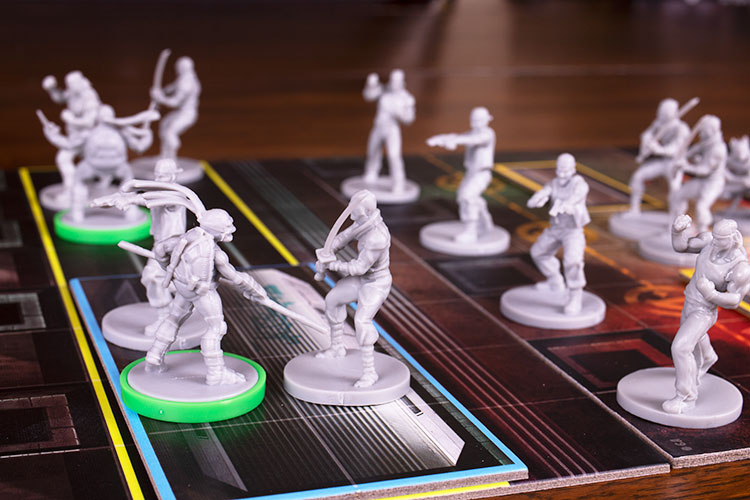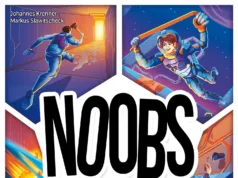 Cowabunga! As a child growing up in the 80s, the Teenage Mutant Ninja Turtles cartoon and arcade game were a staple of my life. I can’t even begin to tell you how many hours I spent watching four mutant turtles beat up on countless foot soldiers. Leonardo, Donatello, Michelangelo, and Raphael. Those renaissance painters became household names for me.
Cowabunga! As a child growing up in the 80s, the Teenage Mutant Ninja Turtles cartoon and arcade game were a staple of my life. I can’t even begin to tell you how many hours I spent watching four mutant turtles beat up on countless foot soldiers. Leonardo, Donatello, Michelangelo, and Raphael. Those renaissance painters became household names for me.
Fast forward to 2016, and IDW Games releases Teenage Mutant Ninja Turtles: Shadows of the Past. While this one looked cool, I didn’t really have a need in my collection for another 1 vs Many game. Sadly, I gave this one a pass and secretly wishing it had been a co-op game. Four years later my wishes were granted as IDW released Teenage Mutant Ninja Turtles: Change is Constant, a reimplementation of Shadows of the Past with an alternate way to play: full co-op!
Gameplay Overview:
There are two ways to play Teenage Mutant Ninja Turtles: Change is Constant (hereafter simply referred to as Change is Constant), either 1 vs Many or fully cooperative. I’m going to focus mainly on the cooperative mode of play for the game, that’s what’s really new here, and there are already plenty of reviews for the Vs mode if you just check out Shadows of the Past. However you chose to play, all missions can be played either fully cooperative or 1 vs Many.

Change is Constant is a mini-campaign style game that will have a group of four heroes taking on a series of missions, four in total per campaign. Each mission will provide a map setup, enemies to include, objectives, and any special rules for the scenario. Most missions will have the players controlling four heroes (chosen from either the turtles or Casey Jones), with the AI handling the enemies.
Each round starts with the players rolling their heroes’ 3 action dice. The results are then arranged in a line in front of the player. The icons on the ends of your line are then shared with the player on your left and right (respectively). Each icon represents an action your hero can take on a turn, so, in essence, each hero will have 5 action icons to use on their turn. Three from their own dice and one from each of their two neighbors.

Then the initiative deck is shuffled and the top card is revealed. That character gets to take their actions. If it’s a hero, they can use their dice icons to move, attack (ranged or melee), or using one of their special ability cards. Combat is handled via dice rolls. Only heroes roll dice for attacks and defense, enemies just have flat values for both.
When an enemy activates, they basically just move and attack, or attack twice (three times for a villain). Enemies will usually just attack the closest hero, with ties being broken by the AI rules on their card. There are a bunch of rules for edge cases, including ranged attacks, but that’s the basics of it.
After all characters have taken an action, the round ends with a cleanup phase and spawning of more minions for your heroes to punch around. The game ends once the objectives of the scenario are met or failed, and the heroes move on to the next mission (win or lose).
This is a pretty high-level overview of how the game is played. If you want to get more into the weeds, you can download a PDF of the rules here.

Game Experience:
I’m always a bit wary when games try to do too much. I see Kickstarters that say “It’s competitive, and semi-cooperative, oh and cooperative too!” Usually, the alternate play modes are tacked on and pretty bad (Masmorra co-op I’m looking at you) or they went off in too many directions and nothing is all that good.
So maybe it’s because Change is Constant is based on the already great Shadows of the Past system, but I found the game to be pretty excellent. And I’m talking both cooperative and competitive. For those curious, the 1 vs Many gameplay is just as good as in Shadows of the Past with some nice quality of life improvements. But let’s start with the basics.

First of all, I really love the dice system in Change is Constant. It fosters communication and interaction between players that really elevates the game to another level. At the start of every round, you roll your dice (and maybe reroll some) and then the discussion happens. “I have no movement”, “do you need a double attack”, “who can give me some defense, I need defense!” are all things you can expect to hear around the table. Much like the trading floor of the stock market, there will be a lot of back and forth as the icons and needs get sorted out.
Dialing down more into the cooperative mode, something else I loved was how the enemies all have flat stats for attack and defense. Something I abhor in co-op games is opposed rolls. It can get super fiddly to roll your attack dice, then have someone else roll defense dice, calculate values, and then repeat… a ton. I much prefer a static “to hit” number that keeps the game smooth and flowing.

As far as the villain AI, for the most part, it works fine. To be honest, there are a lot of tiebreakers and edge cases that can cause headaches for the players if you try to drill too down too much into it. We had the most fun when we just kept it casual and let the game flow. Have the bad guys attack the closest hero, break ties with the enemy preference. If your game group has rules lawyers in them, you might get frustrated with this system. Yet if you are cool with just doing what you think makes the most sense, rounds will go by quickly with lots of action.
I also really enjoyed how the campaigns were in 4 mission arcs. We were able to get through a whole campaign in one game session, which seemed like the perfect fit for the game night. There are also rules for making each mission harder if your group likes to have a challenging experience. The missions themselves have a decent amount of variety, but most boil down to defeating the villain after wading through piles and piles of minions. Baxter Stockman, Alopex, and Old Hob are ready for you to thwart their schemes.

Right about now you are saying, wait, who? Where are Shredder, Bebop, and Rocksteady? Yeah, those are in the other game, Teenage Mutant Ninja Turtles: City Fall. I’m not going to lie, it kind of feels like I’m getting half the experience here. One box has the turtles, the other has the iconic villains. If you want them both, be prepared to shell out the dollars. I’m not sure anyone is going to be a fan of how this was all divided.
The only other gripe I had was I think the designers went a little overboard on the different terrain types. While they thankfully produced a sheet that lists all the effects in one spot, there are about a dozen different types of terrain and it can feel a bit overwhelming at times. It also bogs down setup a bit. However, this is a minor complaint in an otherwise excellent game.
Final Thoughts:
I always approach licensed board games with a healthy dose of caution. Is the IP being used as a crutch to sell the game or is there really a good system here. Teenage Mutant Ninja Turtles: Change is Constant vastly exceeded my expectations. Not only is there a great game here based on a beloved IP, but it finally lets you play in your preferred play style.
The dice sharing system is excellent, the components solid, and the turtles have an almost asymmetrical bent to them (Mikey is nimble, Leo is heavy into melee, etc…). Our group has already burned through half the missions in the short amount of time we’ve had this game, as it’s quickly become a staple on our game night. The combat in this dice chucker is fierce, frequent, and highly engaging. I only wish that the game wasn’t split into two titles. For those looking for an excellent TMNT experience, then pick up Teenage Mutant Ninja Turtles: Change is Constant.
Final Score: 4.5 Stars – An excellent dice chucking game that drops you into the shoes of these iconic heroes, and lets you play how you’ve always wanted to.
 Hits:
Hits:
• Excellent dice action system
• Both cooperative and competitive gameplay
• Campaigns are broken up into four mission arcs
• No opposed rolls for co-op mode
Misses:
• Turtles in one box, iconic villains in a different game
• A bit too many terrain types























